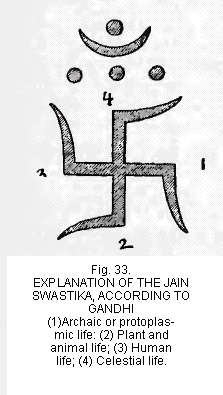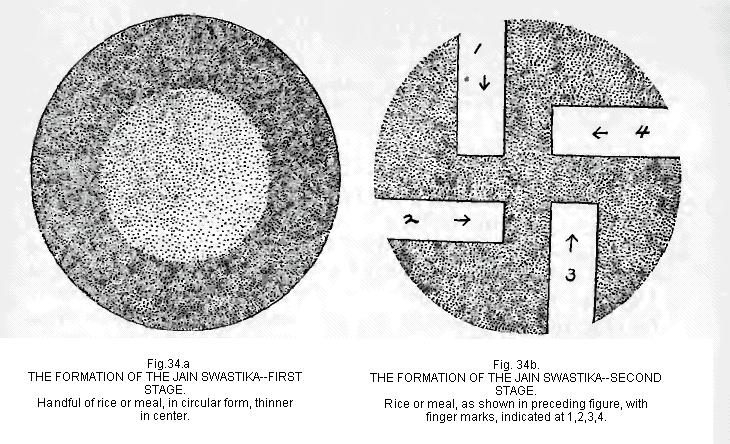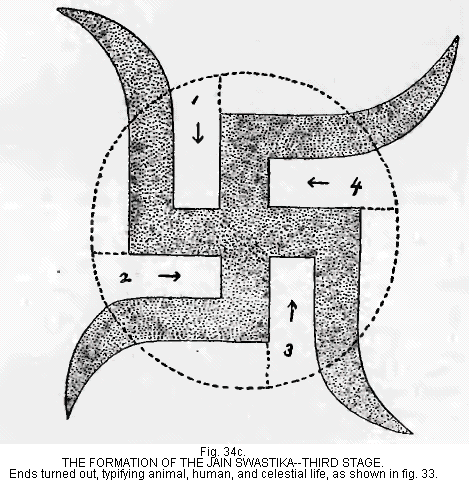

The Swastika
Dispersion of the Swastika
I explain the Jain Swastika by the following illustration [fig.33]
 : the horizontal and vertical lines crossing each other at right angles
form the Greek cross. They represent spirit and matter. We add four other
lines by bending to the right each arm of the cross, then three circles
and the crescent, and a circle within the crescent. The idea thus symbolized
is that there are four grades of existence of souls in the material universe.
The first is the lowest state–Archaic or protoplasmic life. The soul evolves
from that state to the next–the earth with its plant and animal life.
Then follows the third state– the human; then the fourth state–the celestial.
The word “celestial” is here held to mean life in other worlds than our
own. All these graduations are comibnations of matter and soul on different
scales. The spiritual plan is that in which the soul is entirely freed
from the bounds of matter. In order to reach that plane, one must strive
to possess the three jewels (represented by the three circles), right
belief, right knowledge, right conduct. When a person has these, he will
certainly go higher until he reaches the state of liberation, which is
represented by the crescent. The crescent has the form of the rising moon
and is always growing larger. The circle in the crescent represents the
omniscient state of the soul when it has attainned full consciousness,
is liberated, and lives apart from matter.
: the horizontal and vertical lines crossing each other at right angles
form the Greek cross. They represent spirit and matter. We add four other
lines by bending to the right each arm of the cross, then three circles
and the crescent, and a circle within the crescent. The idea thus symbolized
is that there are four grades of existence of souls in the material universe.
The first is the lowest state–Archaic or protoplasmic life. The soul evolves
from that state to the next–the earth with its plant and animal life.
Then follows the third state– the human; then the fourth state–the celestial.
The word “celestial” is here held to mean life in other worlds than our
own. All these graduations are comibnations of matter and soul on different
scales. The spiritual plan is that in which the soul is entirely freed
from the bounds of matter. In order to reach that plane, one must strive
to possess the three jewels (represented by the three circles), right
belief, right knowledge, right conduct. When a person has these, he will
certainly go higher until he reaches the state of liberation, which is
represented by the crescent. The crescent has the form of the rising moon
and is always growing larger. The circle in the crescent represents the
omniscient state of the soul when it has attainned full consciousness,
is liberated, and lives apart from matter. The interpretation, according to the Jain view of the cross, has nothing to do with the combination of the male and female principle. Worship of the male and female principles, ideas based upon sex. lowest even on the emotional plane, can never rise higher than then male and female.
The Jains make the Swastika sign when we enter our temple or worship. This sign reminds us of the great principles represented by the three jewels and by which we are to reach the ultimate good. Those symbols intensify our thoughts and make them ore permanent.
 Mr. Gandhi says the Jains
make the sign of the Swastika as frequently and deftly as the Roman Catholics
make the sign of the cross. It is not confined to the temple nor to the
priests or monks. Whenever or wherever a benediction or blessing is given,
the Swastika is used. Figs. 34 a,b,c form a series showing
Mr. Gandhi says the Jains
make the sign of the Swastika as frequently and deftly as the Roman Catholics
make the sign of the cross. It is not confined to the temple nor to the
priests or monks. Whenever or wherever a benediction or blessing is given,
the Swastika is used. Figs. 34 a,b,c form a series showing how it is made. A handful of rice, meal, flour, sugar, salt, or any similar
substance, is spread over a circular space, say, 3 inches in diameter
and one-eight of an inch deep (fig.34a), then commence at the outside
of the circle (fig. 34b), on its upper or farther left-hand corner,
and draw the finger through the meal just to the left of the center, halfway
or more to the opposite or near edge of the circle (1), then again to
the right (2), then upward (3), finally to the left where it joins with
the first mark (4). The ends are swept outward, the dots and crescent
put in above, and the sign is complete (fig. 34c).
how it is made. A handful of rice, meal, flour, sugar, salt, or any similar
substance, is spread over a circular space, say, 3 inches in diameter
and one-eight of an inch deep (fig.34a), then commence at the outside
of the circle (fig. 34b), on its upper or farther left-hand corner,
and draw the finger through the meal just to the left of the center, halfway
or more to the opposite or near edge of the circle (1), then again to
the right (2), then upward (3), finally to the left where it joins with
the first mark (4). The ends are swept outward, the dots and crescent
put in above, and the sign is complete (fig. 34c).The sign of the Swastika is reported in great numbers, by hundreds if not by thousands, in the inscriptions on the rock walls of the Buddhist caves in India. It is needless to copy them, but is enough to say that they are the same size as the letters forming the inscription; that they all have four arms and the ends turn at right angles, or nearly so, indifferently to the right or to the left. The following list of inscriptions, containing the Swastikas, is taken from the first book coming to hand–the “Report of Dr. James Burgess on the Buddhist Cave Temples and their Inscriptions, Being a part of the result of the fourth,
<< Previous Page Next Page >>
© 2004-2007 Northvegr.
Most of the material on this site is in the public domain. However, many people have worked very hard to bring these texts to you so if you do use the work, we would appreciate it if you could give credit to both the Northvegr site and to the individuals who worked to bring you these texts. A small number of texts are copyrighted and cannot be used without the author's permission. Any text that is copyrighted will have a clear notation of such on the main index page for that text. Inquiries can be sent to info@northvegr.org. Northvegr™ and the Northvegr symbol are trademarks and service marks of the Northvegr Foundation.

|